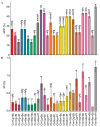Design of Microbial Consortia Based on Arbuscular Mycorrhizal Fungi, Yeasts, and Bacteria to Improve the Biochemical, Nutritional, and Physiological Status of Strawberry Plants Growing under Water Deficits
- PMID: 38891364
- PMCID: PMC11175115
- DOI: 10.3390/plants13111556
Design of Microbial Consortia Based on Arbuscular Mycorrhizal Fungi, Yeasts, and Bacteria to Improve the Biochemical, Nutritional, and Physiological Status of Strawberry Plants Growing under Water Deficits
Abstract
Drought affects several plant physiological characteristics such as photosynthesis, carbon metabolism, and chlorophyll content, causing hormonal and nutritional imbalances and reducing nutrient uptake and transport, which inhibit growth and development. The use of bioinoculants based on plant growth-promoting microorganisms such as plant growth-promoting rhizobacteria (PGPR), yeasts, and arbuscular mycorrhizal fungi (AMF) has been proposed as an alternative to help plants tolerate drought. However, most studies have been based on the use of a single type of microorganism, while consortia studies have been scarcely performed. Therefore, the aim of this study was to evaluate different combinations of three PGPR, three AMF, and three yeasts with plant growth-promoting attributes to improve the biochemical, nutritional, and physiological behavior of strawberry plants growing under severe drought. The results showed that the growth and physiological attributes of the non-inoculated plants were significantly reduced by drought. In contrast, plants inoculated with the association of the fungus Claroideoglomus claroideum, the yeast Naganishia albida, and the rhizobacterium Burkholderia caledonica showed a stronger improvement in tolerance to drought. High biomass, relative water content, fruit number, photosynthetic rate, transpiration, stomatal conductance, quantum yield of photosystem II, N concentration, P concentration, K concentration, antioxidant activities, and chlorophyll contents were significantly improved in inoculated plants by up to 16.6%, 12.4%, 81.2%, 80%, 79.4%, 71.0%, 17.8%, 8.3%, 6.6%, 57.3%, 41%, and 22.5%, respectively, compared to stressed non-inoculated plants. Moreover, decreased malondialdehyde levels by up to 32% were registered. Our results demonstrate the feasibility of maximizing the effects of inoculation with beneficial rhizosphere microorganisms based on the prospect of more efficient combinations among different microbial groups, which is of interest to develop bioinoculants oriented to increase the growth of specific plant species in a global scenario of increasing drought stress.
Keywords: antioxidant activity; arbuscular mycorrhizal fungi; drought stress; microbial consortia; plant growth-promoting microorganisms; strawberry.
Conflict of interest statement
The authors declare that they have no known competing financial interests or personal relationships that could be construed as influencing the work reported in this paper.
Figures






Similar articles
-
Co-inoculation of Arbuscular Mycorrhizal Fungi and the Plant Growth-Promoting Rhizobacteria Improve Growth and Photosynthesis in Tobacco Under Drought Stress by Up-Regulating Antioxidant and Mineral Nutrition Metabolism.Microb Ecol. 2022 May;83(4):971-988. doi: 10.1007/s00248-021-01815-7. Epub 2021 Jul 26. Microb Ecol. 2022. PMID: 34309697
-
Arbuscular mycorrhizal fungus Rhizophagus irregularis alleviates drought stress in soybean with overexpressing the GmSPL9d gene by promoting photosynthetic apparatus and regulating the antioxidant system.Microbiol Res. 2023 Aug;273:127398. doi: 10.1016/j.micres.2023.127398. Epub 2023 May 3. Microbiol Res. 2023. PMID: 37167733
-
Can arbuscular mycorrhizal fungi and rhizobacteria facilitate 33P uptake in maize plants under water stress?Microbiol Res. 2023 Jun;271:127350. doi: 10.1016/j.micres.2023.127350. Epub 2023 Mar 5. Microbiol Res. 2023. PMID: 36913786
-
Role of Arbuscular Mycorrhizal Fungi in Regulating Growth, Enhancing Productivity, and Potentially Influencing Ecosystems under Abiotic and Biotic Stresses.Plants (Basel). 2023 Aug 29;12(17):3102. doi: 10.3390/plants12173102. Plants (Basel). 2023. PMID: 37687353 Free PMC article. Review.
-
Exopolysaccharides producing rhizobacteria and their role in plant growth and drought tolerance.J Basic Microbiol. 2018 Dec;58(12):1009-1022. doi: 10.1002/jobm.201800309. Epub 2018 Sep 5. J Basic Microbiol. 2018. PMID: 30183106 Review.
Cited by
-
The potential of Paraburkholderia species to enhance crop growth.World J Microbiol Biotechnol. 2025 Feb 5;41(2):62. doi: 10.1007/s11274-025-04256-3. World J Microbiol Biotechnol. 2025. PMID: 39904926 Free PMC article. Review.
-
A Comprehensive Review of the Diversity of Fungal Secondary Metabolites and Their Emerging Applications in Healthcare and Environment.Mycobiology. 2024 Dec 3;52(6):335-387. doi: 10.1080/12298093.2024.2416736. eCollection 2024. Mycobiology. 2024. PMID: 39845176 Free PMC article. Review.
-
Physiological, Biochemical, and Genetic Reactions of Winter Wheat to Drought Under the Influence of Plant Growth Promoting Microorganisms and Calcium.Microorganisms. 2025 Apr 30;13(5):1042. doi: 10.3390/microorganisms13051042. Microorganisms. 2025. PMID: 40431214 Free PMC article.
References
-
- Aceituno P., Boisier J.P., Garreaud R., Rondanelli R., Rutllant J.A. Climate and Weather in Chile. In: Fernández B., Gironás J., editors. Water Resources of Chile, World Water Resources. Volume 8. Springer Nature Switzerland AG; Cham, Switzerland: 2021. pp. 7–29.
-
- Garreaud R.D., Boisier J.P., Rondanelli R., Montecinos A., Sepúlveda H.H., Veloso-Aguila D. The Central Chile Mega Drought (2010–2018): A Climate Dynamics Perspective. Int. J. Climatol. 2020;40:421–439. doi: 10.1002/joc.6219. - DOI
-
- Hernández-Martínez N.R., Blanchard C., Wells D., Salazar-Gutiérrez M.R. Current State and Future Perspectives of Commercial Strawberry Production: A Review. Sci. Hortic. 2023;312:111893. doi: 10.1016/j.scienta.2023.111893. - DOI
-
- Yenni, Ibrahim M.H., Nulit R., Sakimin S.Z. Influence of Drought Stress on Growth, Biochemical Changes and Leaf Gas Exchange of Strawberry (Fragaria × ananassa Duch.) in Indonesia. AIMS Agric. Food. 2022;7:37–60. doi: 10.3934/agrfood.2022003. - DOI
Grants and funding
LinkOut - more resources
Full Text Sources

